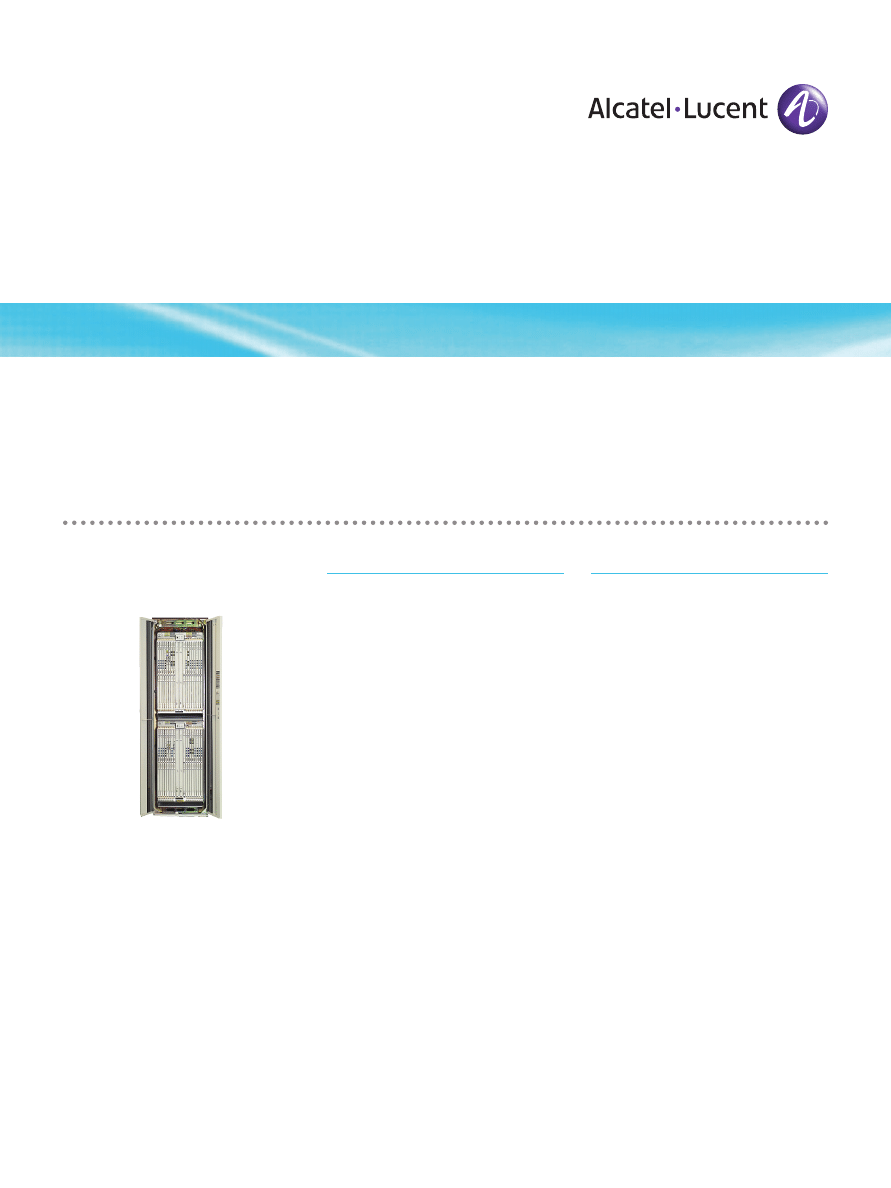
Alcatel-Lucent 1675 LambdaUnite MSS
M U L T I S E R V I C E S W I T C H | R E L E A S E 1 0
The Alcatel-Lucent 1675 LambdaUnite
®
MultiService Switch (MSS) is a well established global 10G optical
switch that enables support for a wide variety of applications in ring and mesh network topologies, while
keeping the network flexible, cost-effective and easy to manage. The Alcatel-Lucent 1675 LambdaUnite MSS
is designed to meet operators’ demanding price and performance requirements for small-to-large applications
in metropolitan and backbone networks.
Features
• Flexible “any card in any slot”
architecture
• Multiple capacity options in a
single shelf
• In-service insertion and provisioning
of expansion-port modules, with
in-service upgrades to higher-capacity
configurations
• Sophisticated protection schemes,
with access to protection bandwidth
and hardware redundancy
• Ethernet transport with dynamic link
capacity adjustment scheme (LCAS)
and virtual concatenation
• Built-in line rate, capacity and density
enhancements and simultaneous
ring and mesh support
• Network-embedded intelligence
(ASON/GMPLS)
Benefits
• Minimizes equipment types and
increases revenue opportunities
for rapid feature introduction
• With single-shelf capacity
options, reduces floor space
and operating costs
• Provides built-in scalability and
minimizes service downtime
• Protects system resources with
sophisticated availability and
reliability features
• Enables rich multiservice support
• Eases migration and allows for future
network topologies and growth

www.alcatel-lucent.com
Alcatel, Lucent, Alcatel-Lucent and the Alcatel-Lucent logo
are trademarks of Alcatel-Lucent. All other trademarks are the property of their respective owners.
The information presented is subject to change without notice. Alcatel-Lucent assumes no responsibility
for inaccuracies contained herein. Copyright © 2009 Alcatel-Lucent. All rights reserved.
CPG4688091207 (12)
Technical specifications
Applications
• 2.5G/10G multiple-ring terminal
for metro, regional and backbone
networks
• 10G backbone feeder and
transoceanic deployments, with
sub-lambda grooming service
• Hybrid ring and mesh
• Ethernet transport
Topologies
• Multiple ring (2F/4F MS-SPRing/
BLSR, 4F TOP+EX, UPSR/SNCP,
DNI/DRI)
• Point-to-point (0x1, MSP/APS 1+1)
• Mesh
Optics
• CWDM, PWDM and DWDM direct
compatible optics
• VSR to LR
Interfaces
• 2-port OC-192/STM-64 (XFP)
• 8-port OC-48/STM-16 (SFP)
• 8-port (SFP) or 16-port (fixed)
OC-12/STM-4
• 8-port (SFP) or 16-port (fixed)
OC-3/STM-1
• Ethernet Private Line (EPL)
¬ 1-port 10GigE (XFP)
¬ 8-port GigE (SFP)
• 8-port STM-1 (electrical)
• 36-port DS3 (electrical)
• “Any card in any slot” architecture
• Per-port SDH/SONET provisioning
• I-NNI, UNI 1.0 R2, and E-NNI R1.0
Switch architecture/connectivity
• Redundant switch fabric (including
160G, 320G and 640G capacities)
and timing unit, providing non-
blocking connectivity at AU-4/HO
VC-3 and STS-1 levels
• Concatenation up to
AU-4/4c/16c/64c,
STS-1/3c/12c/48c/192c,
including pipe mode
• 40G VC-12/VC-3 or VT-1.5 LO-XC
adjunct switch fabric
• TransMux, converts DS1 within
channelized DS3 into VT1.5 signals
¬ 2.5 Gbit/s capacity
¬ up to 12 protected pairs
per system
• Dual system controllers (1+1)
(optional)
Connectors
• LC
• Conversion solutions to other
common connector types available
Timing/synchronization
• Timing inputs/outputs: DS1
Telcordia/ITU-T 2 MHz, 2 Mb/s
• Timing quality: Stratum 3
• System timing reference selection
according to:
¬ ETSI 300417-1-1/ITU-T G.781
¬ GR-253-CORE
Fault/performance monitoring
• GR-253-CORE, ITU-T G.783/
G.784/G.826
• Local NE alarm indication: critical/
major/minor alarm LED
• Autonomous alarm forwarding
• Remote Test Access (RTA)
Network management
• Transport protocols
¬ OSI
¬ TCP/IP
¬ DCCm, DCCr
• Ethernet communication ports
• TL1 management interface
• Management systems
¬ Alcatel-Lucent Optical
Management System (OMS)
¬ Alcatel-Lucent 1340 Integrated
Network Controller (INC)
¬ Alcatel-Lucent Craft Interface (CIT)
¬ Telcordia-compliant OS
Dimensions
• Subrack design: ETSI/GR-78-CORE
compliant
• Height: 95 cm (37.4 in.)
• Width: 50 cm (19.7 in.)
• Depth: 54.6 cm (21.5 in.)
• Two systems per ETSI 220 cm
(86.6 in.)/260 cm (102.4 in.) rack
or GR-63-CORE (NEBS 2000)
212.6 cm (83.7 in.) rack
Rack design
• ETSI-2 rack
¬ Height: 220 cm (86.6 in.)
¬ Width: 60 cm (23.6 in.)
¬ Depth: 60 cm (23.6 in.)
• GR-63-CORE (NEBS 2000) rack
¬ Height: 212.6 cm (83.7 in.)
¬ Width: 60 cm (23.6 in.)
¬ Depth: 60 cm (23.6 in.)
• Earthquake safety standards: both
subrack-rack combinations certified
for risk zone 4 (GR-63-CORE)
Power
• Redundant primary power supply
voltage: -60 V/-48 V nominal
• Operation range: -40 V to -72 V
• Power consumption: typical 2500
W per NE
Operating environment
• EMC
¬ EN 300 386-2
¬ IEC 61000-4-x (immunity)
¬ GR-1089-CORE (emission/
immunity)
• ETSI 300 019
¬ ETSI Class 3.1e operating
temperature 5°C to 40°C
(41°F to 104°F); short term
-5°C to +50°C (23°F to 122°F)
¬ ETSI Class 1.2 (storage)
¬ ETSI Class 2.3 (transportation)
• GR-63-CORE
¬ Operating temperature: 5°C to
40°C (41°F to 104°F)
¬ Short-term: -5°C to +50°C
(23°F to 122°F)
• Humidity:
¬ Operating: 5% to 85%
¬ Short-term: 5% to 90%
• Noise
¬ ETSI 300 753
¬ GR-63-Core Sec.4.6
• Laser safety: IEC 60825 hazard
level 1 or 3A for all circuit packs
Certifications
• Metro Ethernet Forum — Ethernet
Services (MEF 9 - EPL, EVPL, ELAN)
• CE marking
• NEBS Level 3
• FDA approved
• UL listed
Wyszukiwarka
Podobne podstrony:
Datasheet SL4 100
Datasheet QS10 241 C1
LAMBDA termochemia spalania paliwa
Datasheet YR2 DIODE
pdf datasheet 5 id 352824 Nieznany
1675
datasheet (2)
Citroen C4 Picasso Datasheet
datasheet
Datasheet SL5 300
LBB441850 DataSheet plPL E3338100491
AFR wskaźnik sondy lambda
Datasheet ML15 051
Datasheet SL10 305
Datasheet SL20 303
PLN 1P1000 DataSheet plPL E3242294027
Datasheet QT20 241 C1
więcej podobnych podstron